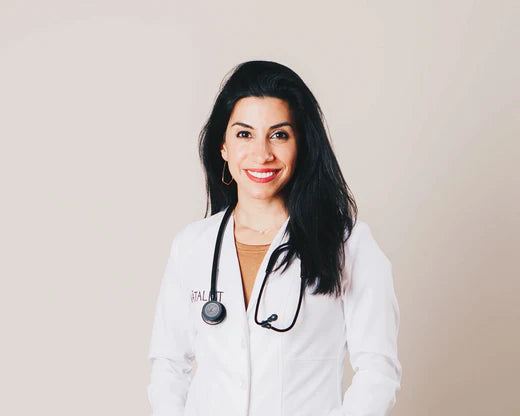Scheduling Your Mammogram

Dr. Naz answers the questions you've always wondered about this very important aspect of your breast health: scheduling your mammogram.
1. Can you explain what a mammogram is and why it’s so important?
A mammogram is an X-ray picture of the breast and is the best first screening technique for any breast abnormalities that may look concerning for cancer. Breast cancer is the most frequent cause of cancer death in women worldwide and the second most frequent cause of cancer death among women in the United States.
2. At what age do you recommend a woman have her first mammogram?
You’d think this would be an easy question to answer, but the American Cancer Society, The American College of Obstetricians and Gynecologist (ACOG), the US Preventative Task Force, and the National Comprehensive Cancer Network all weigh in on this, and their recommendations are worded slightly differently! ACOG recommends offering mammography to average-risk women beginning at age 40 and to initiate screening by no later than age 50. This recommendation is consistent with all three major consensus guidelines.
The majority of women are at average risk of developing breast cancer: that’s less than a 15% lifetime risk. In these women, age is the most important factor in determining when she should be screened because the incidence of breast cancer increases with age. Starting at the age of 40, you and your healthcare provider should discuss your risk factors for breast cancer and decide on the best time to start screening. We call this patient-provider shared decision making.
For women with the following risk factors, we consider earlier screening than age 40:
- Personal and family history of breast, ovarian cancer, fallopian tube cancer, or peritoneal cancer
- Known carrier or family history of BRCA1 or BRCA2 mutations
- A previous breast biopsy with a high-risk lesion (like atypical hyperplasia)
- A history of radiation therapy between the ages of 10-30
If any of the above following apply to you, please bring it up with your primary care doctor or your OB/GYN (Obstetrician/gynecologist) so they can refer you to a breast specialist for further counseling and provide a referral to a genetics counselor.
Why might you choose to delay mammograms until 50? Screening can expose women to potential harms, such as callbacks, anxiety, false-positive results, overdiagnosis, and overtreatment. Women in their forties have a high chance (almost 50%) of being called back for additional studies or a biopsy, with a low chance (less than one in ten) that a cancer will actually be found. If you decide to wait on screening because you are low risk, talk to your provider about whether or not a breast exam is indicated. We are now recommending that health care providers spend more time assessing risk for cancer and counseling on those risks rather than doing exams. Surprising, I know! The American Cancer Society and US Preventative Task Force do not recommend routine breast exams by your healthcare provider. ACOG says you should talk to your provider to see if you merit a breast exam and that patients should practice breast self-awareness.
Fun fact: breast self-awareness is not the same as breast self-examination. Per the American College of Obstetricians and Gynecologist, breast self-awareness is defined as a woman’s awareness of the normal appearance and feel of her breasts. It’s different from breast self-examination which is regular, repetitive inspection of the breast for the purpose of detecting cancer.
3. How often should she have one? Should that frequency change as a woman gets older?
The recommendations are slightly different between the society guidelines. In general, mammograms should be conducted every one to two years from the age of starting until the age of 75.
Breast cancer is made up of several types: some that are aggressive and grow quickly, and some that grow less quickly. Mammography makes the biggest impact on women with slow and moderate growth tumors, which are most common for women 50 years and older. Because the tumors are slow growing, you may choose to space out your mammograms to every one and a half to two years. If they do have breast cancer, women in the less than 50 age group are more likely to have faster growing tumors, so it may make sense to screen annually if they are going to screen. After the age of 75, women should have a discussion with their provider about the need for screening.
4. For the reader about to have her first mammogram, is there anything she can expect from the process that people don’t necessarily discuss? (i.e. Does it hurt? How invasive is it? etc.)
FYI: Planned Parenthood has an excellent description here.
I always think of the movie “This is 40” where Leslie Mann suffers through her breasts being squished in the mammogram machine! Truth be told, it’s usually not as painful as portrayed; everyone’s experience is different.
Mammograms are usually done in a radiology office. When you arrive, you will get undressed from the waist up and will be provided with a gown or cover-up. It’s important not to wear deodorant, lotions, oils, or perfumes on the day of your exam, as these will interfere with the machine. Usually, it will just be you and the technician in the X-ray room. The radiology technician will position you in front of an X-ray machine and carefully place your breasts, one at a time, between two plastic imaging plates. The plates are used to apply pressure to the breast to flatten it and get the best images of the breast from different angles. This pressure is usually what causes discomfort and can depend on your breast shape and size. The more relaxed you can be, the better. The process should take about 10-15 minutes total. Afterward the technician will show the images to a doctor, called a radiologist, who will review the mammogram for any findings. Before you leave, ask the office when you should expect to hear results—sometimes it can take 48 hours to one week. Some people worry about exposure to radiation from the X-ray, but the amount of radiation is really small.
Other things to keep in mind:
- When you make your appointment, tell the scheduler if you have breast implants.
- Try to avoid a mammogram the week before or during your period when the breasts can feel more tender.
- Let your doctor know if you are pregnant; we generally avoid screening mammograms during pregnancy.
5. How should a woman go about finding the best doctor or practitioner for her mammogram and scheduling her appointment?
Usually your primary care or gynecology provider will order a screening mammogram for you after you’ve had a discussion about the best time to start. Hopefully, this is someone with whom you’ve had some continuity of care. They will give you the name of a radiology office to call to schedule your mammogram. If it makes you feel more comfortable, when scheduling your appointment, specify that you prefer the technician to be of the same gender.
🌟 Shop Fertility and Pregnancy Products ⟶
6. What are the next steps after a woman obtains her results?
If you haven’t received your mammogram results within a month, call your provider’s office to check in. If the results are normal, awesome! Check in with your provider about how frequently you need to get screening (every one or two years?). If you find out that you have an abnormal result, try not to panic. Less than one out of ten people called back for an abnormal result will actually have breast cancer. Remember, in women under the age of 50, the chance of a false positive—or something showing up that’s really not cancer—are higher.
If you have an abnormal result, your provider may recommend one of the following:
- Diagnostic mammogram: a mammogram that is more focused on something that looks abnormal.
- Ultrasound: ultrasonography uses sound waves to produce pictures of the breast.
- Fine needle aspiration (FNA) or core-needle biopsy: breast tissue or fluid is sampled and removed with a hollow needle with local anesthesia (the area is usually numbed). The needle for an FNA is very thin. These procedures are usually done in clinic.
- Surgical biopsy: usually done in an operating room under more anesthesia. A small amount of tissue is removed from the breast and analyzed for cancer cells.
7. Any other words on mammograms?
If you develop a new mass in your breast, make sure to bring it to the attention of your provider, even if you have had a recent mammogram that is normal. Rapidly growing tumors are more common in young women, but can arise at any age. Women should be familiar with how their breasts feel and be able to recognize a change. The fastest growing tumors can arise quickly and women themselves are in the best position to find them and bring them to medical attention.























